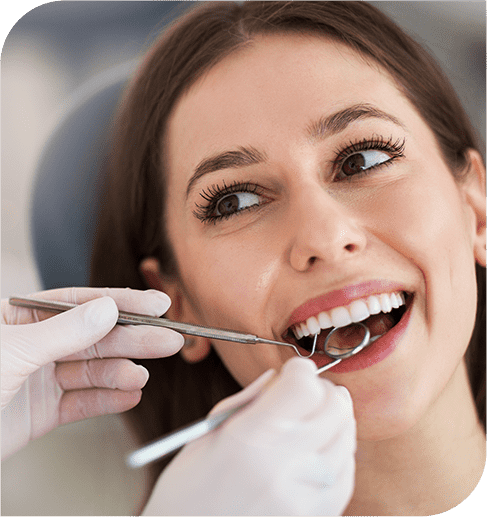Achieving a perfect smile can be a challenge for many of us due to various dental issues. Dental imperfections, such as chipped or cracked teeth, discolorations, or noticeable gaps, can significantly impact both your self-esteem and overall appearance. Luckily, through cosmetic dentistry, those seeking to overcome these challenges can attain the smile they've always dreamed of. This specialized field of dentistry combines artistry and science to create dental transformations that go beyond aesthetics.
At Valencia Advanced Dentistry at Copperhill Smiles, we understand the significant impact that a beautiful smile can have on your life. Our dedicated team of skilled cosmetic dentists in Santa Clarita is committed to helping you achieve the confident and radiant smile you deserve.
Understanding Cosmetic Dentistry
Cosmetic dentistry is a specialized field that aims to improve a person’s aesthetics of their smile. Unlike traditional dentistry, which focuses on overall oral health, cosmetic dentistry takes oral care a step further by enhancing the appearance of teeth and gums.
It aims to create smiles that are not only beautiful but also natural-looking and harmonious with the individual's facial features. This branch of dentistry combines the precision of science with the artistry of skilled dentists to achieve remarkable transformations in the way teeth look and function.
The key distinction of cosmetic dentistry lies in its emphasis on elective procedures rather than essential dental care. While general dentistry addresses essential oral health issues like cavities, gum disease, and tooth extractions, cosmetic dentistry deals with elective treatments that people choose to enhance their smile.
Common Cosmetic Dental Procedures
Cosmetic dental procedures have revolutionized the way we perceive and achieve a beautiful smile. Whether you have minor imperfections that bother you or desire a complete smile makeover, cosmetic dentistry offers a diverse array of treatments to suit your needs. Here are some of the most common and transformative cosmetic dental procedures:
Teeth Whitening
Over time, teeth can become stained or discolored due to factors like age, dietary choices, or smoking. Teeth whitening, also known as bleaching, is a non-invasive procedure that can restore the natural brightness of your teeth. It's a quick and effective way to achieve a radiant smile.
Understanding Teeth Discoloration
Before delving into the teeth whitening process, it's essential to understand the common causes of tooth discoloration:
- Extrinsic Stains — These occur on the outer surface of the teeth and are often caused by factors such as consuming coffee, tea, red wine, or tobacco. Poor dental hygiene and certain foods can also contribute to extrinsic stains.
- Intrinsic Stains — These stains develop within the tooth's structure, often as a result of factors like genetics, medication use during tooth development, or dental trauma. Intrinsic stains are typically more challenging to remove than extrinsic ones.
- Age-Related Changes — As we age, the enamel layer on our teeth naturally thins, revealing the yellowish dentin beneath. This can make teeth appear dull and discolored.
Teeth Whitening Process
Teeth whitening is a cosmetic dental procedure designed to remove or reduce stains and discoloration, restoring the natural whiteness of teeth. There are two primary methods for teeth whitening:
In-Office Teeth Whitening
This is the fastest and most effective way to whiten teeth. During an in-office procedure, a high-concentration whitening gel is applied to the teeth, and a special light or laser is used to activate the gel and enhance its effectiveness. In just one visit, teeth can become several shades whiter.
At-Home Teeth Whitening
At-home whitening kits typically involve the use of custom-made trays filled with a lower-concentration whitening gel. These trays are worn for a specified period each day, often for a few weeks, to achieve gradual results. While not as immediate as in-office whitening, at-home kits can still produce impressive results.
Benefits of Teeth Whitening
Teeth whitening offers numerous benefits beyond a more attractive smile:
- Improved Confidence — A brighter smile can boost self-esteem and confidence, encouraging individuals to smile more often and interact with greater assurance.
- Youthful Appearance — Whiter teeth can take years off your appearance, contributing to a more youthful look.
- Positive First Impressions — A white, healthy smile makes a positive first impression in social and professional settings, enhancing your overall image.
- Non-Invasive — Teeth whitening is a non-invasive procedure that does not require altering the tooth's structure, making it a safe and reversible option.
Considerations and Maintenance
It's important to note that teeth whitening may not be suitable for everyone. Individuals with certain dental conditions or severe intrinsic staining may not achieve the desired results. Additionally, teeth whitening is not a permanent solution, and results can fade over time, especially with the consumption of staining substances.
To maintain your newly whitened smile, it's essential to practice good oral hygiene, limit the consumption of stain-causing foods and beverages, and follow your dentist's recommendations for touch-up treatments.
Dental Veneers
Dental veneers are thin, custom-made shells typically crafted from porcelain or composite resin. These shells are meticulously designed to fit over the front surface of your teeth, effectively concealing imperfections and enhancing the overall appearance of your smile. Veneers are known for their ability to provide immediate and dramatic results, making them a popular choice among those seeking a smile makeover.
The Dental Veneer Process
The journey to a rejuvenated smile through dental veneers involves several steps:
Consultation
The process begins with a consultation with a cosmetic dentist. During this initial meeting, you can discuss your goals and expectations. Your dentist will assess your oral health, discuss the veneer options suitable for you, and create a customized treatment plan.
Preparation
To prepare your teeth for veneers, a small amount of enamel is usually removed from the tooth's front surface. This step is essential to ensure the veneers fit seamlessly and look natural. In some cases, minimal to no enamel reduction may be necessary, depending on the type of veneers chosen.
Impressions
After preparing the teeth, your dentist will take precise impressions. These impressions are used to create your custom veneers, ensuring a perfect fit and a natural look.
Temporary Veneers: While your permanent veneers are being fabricated, you may receive temporary veneers to protect your prepared teeth and maintain your smile's appearance.
Bonding
Once the veneers are ready, your dentist will carefully bond them to your teeth using a strong adhesive. Special curing lights are often used to harden the bonding material quickly. After bonding, your veneers are polished to perfection.
Benefits of Dental Veneers
Dental veneers offer a multitude of advantages, making them a sought-after cosmetic dental solution:
- Enhanced Aesthetics — Veneers can correct a wide range of cosmetic issues, including stains, chips, cracks, gaps, and misalignments, resulting in a stunning and uniform smile.
- Immediate Results — Veneers provide an almost instant transformation, dramatically improving your smile's appearance in just a few dental visits.
- Natural Look — Veneers are customized to match the color, shape, and translucency of your natural teeth, ensuring a seamless blend with your smile.
- Durability — With proper care, veneers can last for many years, providing a long-lasting solution to cosmetic dental concerns.
- Minimal Maintenance — Veneers require no special maintenance beyond regular oral hygiene practices, making them a convenient option.
Considerations and Care
While dental veneers are a versatile and effective cosmetic solution, they may not be suitable for everyone. Your dentist will assess your oral health and discuss alternatives if necessary. Additionally, it's important to maintain good oral hygiene, avoid excessive force or pressure on veneered teeth (such as biting hard objects), and attend regular dental check-ups to ensure the longevity of your veneers.
Dental Implants
Dental implants are artificial tooth roots made from biocompatible materials like titanium. These implant posts are surgically placed into the jawbone, where they fuse with the bone through a process called osseointegration. Once the implant is fully integrated, it serves as a stable and durable foundation for various dental restorations, such as crowns, bridges, or dentures.
The Dental Implant Process
The journey to regaining a complete smile through dental implants typically involves several stages:
Consultation
The process begins with a comprehensive examination by a skilled implant dentist. During this consultation, your oral health is assessed, and your dentist will discuss your treatment plan, addressing any questions or concerns you may have.
Implant Placement
The next step involves the surgical placement of the dental implant into the jawbone. This procedure is performed under local anesthesia, ensuring minimal discomfort. Over the next few months, the implant undergoes osseointegration, becoming a solid and stable anchor for future restoration.
Restoration
Finally, a custom-designed crown or denture is securely attached, completing the restoration.
Benefits of Dental Implants
Dental implants offer a wealth of advantages, making them a preferred choice for tooth replacement:
Natural Look and Feel: Implants closely mimic the appearance and function of natural teeth, providing a harmonious and comfortable solution.
- Durability — Implants are designed to last for many years, often a lifetime, with proper care.
- Enhanced Chewing and Speech — Implants restore full biting and chewing capacity, allowing you to enjoy your favorite foods and speak with clarity.
- Improved Self-Confidence — A complete and beautiful smile boosts self-esteem and positively impacts social interactions and professional opportunities.
Considerations and Care
While dental implants are an outstanding solution for tooth loss, not everyone is an ideal candidate. Factors like overall health, jawbone density, and oral hygiene habits play a role in determining suitability. Regular oral hygiene practices and routine dental check-ups are essential to maintain the longevity of your dental implant and restoration.
Cosmetic Bonding
Cosmetic bonding, often referred to as dental bonding, is a cosmetic dentistry technique that involves the application of a tooth-colored composite resin material to the teeth. This resin is meticulously shaped, sculpted, and polished to correct imperfections and enhance the overall appearance of the teeth. The term "bonding" originates from the process of securely bonding or adhering the resin to the natural tooth structure.
The Cosmetic Bonding Process
The journey to a renewed smile through cosmetic bonding typically involves the following steps:
Consultation
Your dental professional will begin with a consultation to assess your oral health and discuss your specific cosmetic goals. Cosmetic bonding is ideal for minor dental imperfections, and your dentist will help determine if it's the right solution for you.
Preparation
Unlike some other cosmetic procedures, cosmetic bonding often requires little to no tooth preparation. In many cases, the dentist can proceed directly to the bonding process.
Bonding
The dentist will apply the tooth-colored composite resin to the affected tooth or teeth. This resin is carefully sculpted to correct imperfections, reshape the tooth, or close gaps, achieving the desired aesthetic outcome.
Curing
A special curing light is used to harden and set the resin in place. This ensures the material bonds securely to the tooth structure.
Finishing Touches
After the bonding material is cured, your dentist will trim, shape, and polish it to create a seamless and natural appearance that blends harmoniously with your existing teeth.
Benefits of Cosmetic Bonding
Cosmetic bonding offers numerous advantages, making it an attractive choice for those seeking to enhance their smiles:
- Minimally Invasive — Unlike some cosmetic procedures that require significant tooth reduction, cosmetic bonding preserves the natural tooth structure, making it a conservative and reversible option.
- Speed and Convenience — Cosmetic bonding is typically completed in a single dental visit, providing immediate results without the need for multiple appointments.
- Versatility — Bonding can address a wide range of minor cosmetic issues, including chips, cracks, gaps, and uneven tooth surfaces.
- Natural Appearance — The composite resin material is meticulously matched to the shade and texture of your natural teeth, ensuring a seamless and realistic appearance.
- Affordability — Cosmetic bonding is often a cost-effective alternative to more extensive cosmetic treatments.
Considerations and Care
While cosmetic bonding is a versatile and effective solution, it may not be suitable for everyone or significant dental concerns. Additionally, a bonding material is not as stain-resistant as natural enamel, so it may require touch-ups or adjustments over time. Practicing good oral hygiene and avoiding habits like biting on hard objects can help maintain the longevity of the bonding material.
Gum Contouring
Gum contouring is a dental procedure that involves the removal or reshaping of excess gum tissue to achieve a more harmonious and balanced gum line. This process can expose more of the tooth's surface, creating the illusion of longer and more proportionate teeth. Gum contouring is often used to correct a "gummy smile," where a significant portion of the gums is visible when smiling.
The Gum Contouring Process
The journey to a beautifully balanced smile through gum contouring generally involves the following steps:
Consultation
The process begins with a consultation with a skilled cosmetic dentist. During this initial meeting, you can discuss your cosmetic goals, and your dentist will assess your oral health and evaluate the extent of gum reshaping required.
Preparation
Before the procedure, local anesthesia is administered to ensure your comfort during the treatment. This numbing agent ensures that you won't experience pain or discomfort during the procedure.
Gum Reshaping
Using precise and minimally invasive techniques, the dentist carefully removes or reshapes excess gum tissue. Specialized instruments and lasers may be used for accuracy and precision.
Contouring
Once the excess tissue is removed, the dentist sculpts the gum line to create a balanced and aesthetically pleasing appearance. Attention is paid to achieving symmetry and proportionality.
Recovery
Gum contouring is typically well-tolerated, and most patients can resume their normal activities shortly after the procedure. Some minor discomfort, swelling, or sensitivity may occur but is usually temporary and manageable with over-the-counter pain medication.
Benefits of Gum Contouring
Gum contouring offers several advantages, making it a valuable cosmetic dental procedure:
- Enhanced Aesthetics — Gum contouring can significantly improve the appearance of your smile by creating a more balanced and attractive gum line.
- Increased Confidence — A more proportionate and less gummy smile can boost your self-esteem and confidence, leading to more natural and relaxed smiling.
- Improved Oral Health — In some cases, gum contouring may help individuals maintain better oral hygiene, as excessive gum tissue can make cleaning teeth and gums more challenging.
- Minimally Invasive — Gum contouring is a minimally invasive procedure with relatively quick recovery, making it accessible and convenient.
Considerations and Care
While gum contouring is a safe and effective procedure, it may not be suitable for everyone or more complex dental concerns. After the procedure, it's crucial to follow your dentist's post-operative instructions, which may include specific care and hygiene practices to promote proper healing and maintain your new gum line.
Smile Makeovers
A smile makeover is a tailored and comprehensive dental treatment plan that combines various cosmetic procedures to address a range of aesthetic and functional concerns. The goal is to create a smile that is not only beautiful but also harmonious with the individual's facial features, enhancing their overall appearance and self-confidence.
The Smile Makeover Process
The journey to a radiant and confident smile through a smile makeover typically involves the following steps:
Consultation
The process begins with a thorough consultation with an experienced cosmetic dentist. During this initial meeting, you can discuss your cosmetic goals and concerns. Your dentist will evaluate your oral health, including the condition of your teeth, gums, and bite.
Customized Treatment Plan
Based on the assessment and your goals, your dentist will create a personalized treatment plan. This plan may include a combination of procedures such as teeth whitening, dental veneers, orthodontics, dental implants, gum contouring, and more.
Treatment Phases
The smile makeover is executed in stages, with each procedure carefully planned and executed to achieve the desired results. The order and duration of treatments will vary depending on the individual's needs.
Finishing Touches
After the procedures are complete, your dentist will ensure that the final result is both aesthetically pleasing and functionally sound. This may involve adjustments and fine-tuning to achieve the perfect smile.
Benefits of Smile Makeovers
Smile makeovers offer a multitude of advantages, making them a sought-after cosmetic dental solution:
- Comprehensive Transformation — Smile makeovers address multiple dental concerns in one cohesive plan, ensuring that every aspect of your smile is improved.
- Aesthetically Pleasing — The result is a balanced and harmonious smile that enhances your facial features and radiates confidence.
- Boosted Self-Esteem — A beautiful smile can significantly boost self-confidence and positively impact personal and professional relationships.
- Improved Oral Health — Many procedures included in smile makeovers also contribute to better oral health by addressing issues like misalignments, bite problems, or gum disease.
- Long-Lasting Results — With proper care and maintenance, the results of a smile makeover can last for many years, offering a lasting improvement to your smile.
Considerations and Care
Smile makeovers are a highly individualized process, and not all individuals may be suitable candidates. It's essential to maintain good oral hygiene, attend regular dental check-ups, and follow your dentist's recommendations for post-treatment care and maintenance to ensure the longevity of your new smile.
Orthodontic Treatments
Orthodontic treatments have seamlessly integrated into the realm of cosmetic dentistry, offering solutions to a wide range of aesthetic concerns, including:
Crooked Teeth
Orthodontics can correct misaligned teeth, ensuring they are straight and evenly spaced for a more visually appealing smile.
Overcrowding
Overcrowded teeth can not only affect your bite but also diminish the beauty of your smile. Orthodontic treatments like braces or clear aligners can create space and alignment.
Gaps
Orthodontics can effectively close gaps or spaces between teeth, creating a more harmonious and attractive smile.
Bite Problems
Beyond appearance, orthodontic treatments can address bite issues like overbites, underbites, and crossbites, improving both function and aesthetics.
Orthodontic Treatment Options
Several orthodontic treatments are available to address cosmetic concerns, each with its unique advantages:
Braces
Traditional metal braces remain a reliable option for comprehensive orthodontic corrections. They are highly effective in treating various dental issues.
Clear Aligners
Invisalign and similar clear aligner systems offer a discreet and comfortable alternative to traditional braces. They are particularly popular among adults seeking a less conspicuous treatment option.
Lingual Braces
These braces are attached to the back (lingual) surface of the teeth, making them virtually invisible. They are an excellent choice for those who prefer discreet treatment.
Accelerated Orthodontics
Innovative techniques like accelerated orthodontics can expedite treatment duration, providing quicker results for those who wish to achieve a beautiful smile in less time.
Benefits of Cosmetic Orthodontic Treatments
Embracing orthodontic treatments as part of cosmetic dentistry offers numerous advantages:
- Enhanced Aesthetics — Orthodontic treatments create a harmonious and visually pleasing smile, boosting self-esteem and confidence.
- Improved Oral Health — A properly aligned bite and straight teeth are easier to clean, reducing the risk of dental problems such as cavities and gum disease.
- Long-Lasting Results — Orthodontic corrections can provide a beautiful smile that lasts a lifetime with proper maintenance.
- Versatility — Orthodontics can address a wide range of cosmetic concerns, making it a versatile and customizable solution.
Considerations and Care
Orthodontic treatments are highly effective, but they require commitment and care. Proper oral hygiene, regular dental check-ups, and adherence to your orthodontist's recommendations are essential for achieving and maintaining the best results.
Find a Cosmetic Dentist Near Me
Whether you desire a subtle enhancement or a complete smile makeover, our team of skilled and compassionate professionals at Valencia Advanced Dentistry at Copperhill Smiles in Santa Clarita can help you. With state-of-the-art technology and a patient-centered approach, we ensure that our patients receive high-quality care and attention. Call us today at 661-775-7717.





